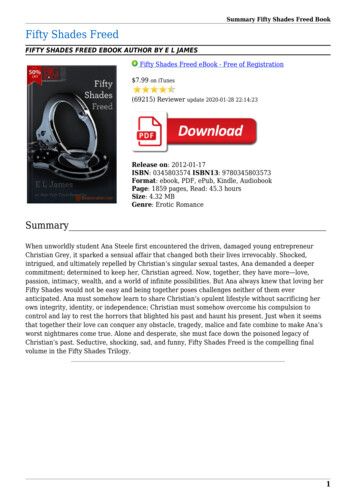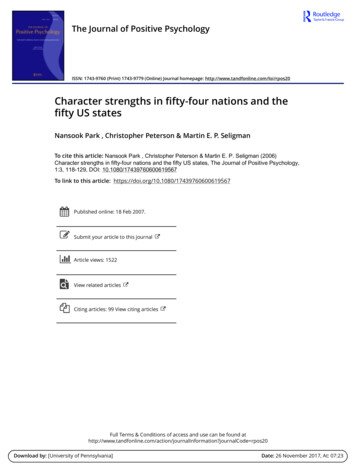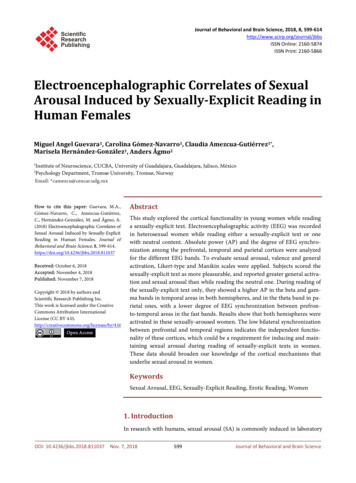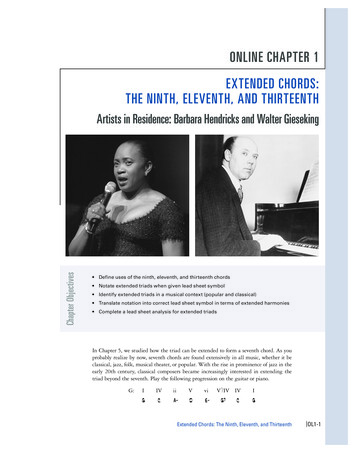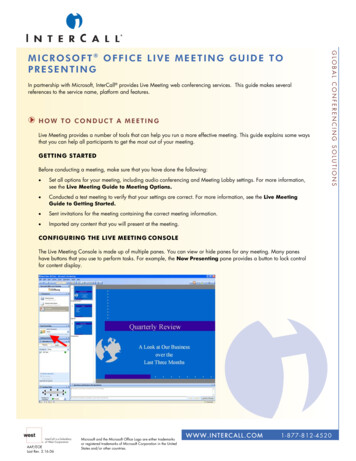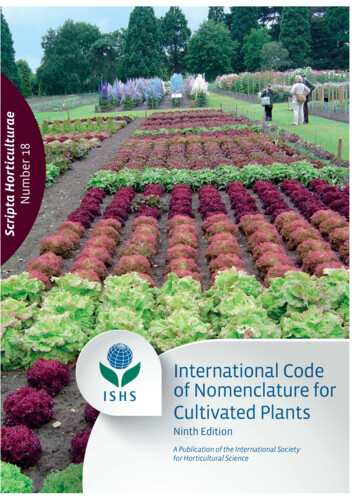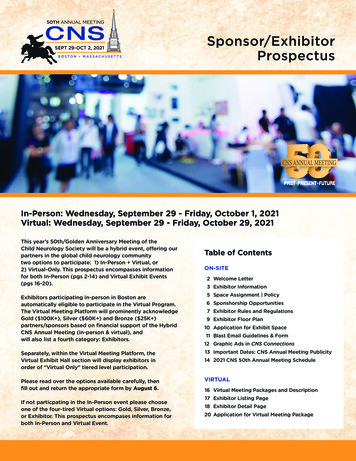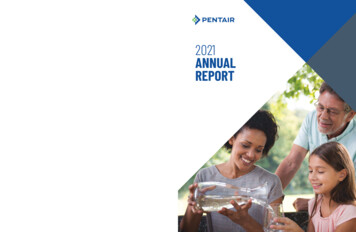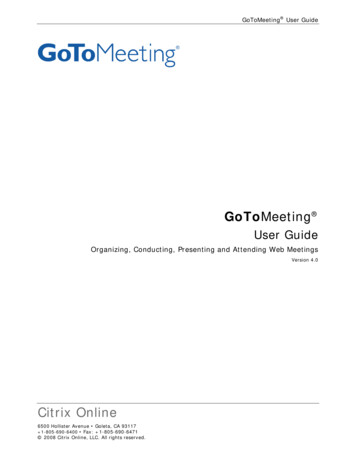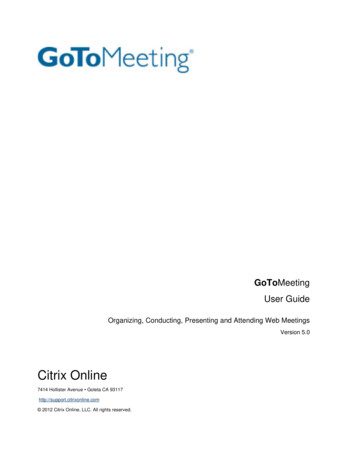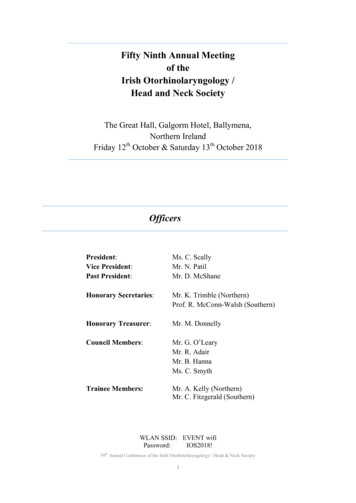
Transcription
Fifty Ninth Annual Meetingof theIrish Otorhinolaryngology /Head and Neck SocietyThe Great Hall, Galgorm Hotel, Ballymena,Northern IrelandthFriday 12 October & Saturday 13th October 2018OfficersPresident:Vice President:Past President:Ms. C. ScallyMr. N. PatilMr. D. McShaneHonorary Secretaries:Mr. K. Trimble (Northern)Prof. R. McConn-Walsh (Southern)Honorary Treasurer:Mr. M. DonnellyCouncil Members:Mr. G. O’LearyMr. R. AdairMr. B. HannaMs. C. SmythTrainee Members:Mr. A. Kelly (Northern)Mr. C. Fitzgerald (Southern)WLAN SSID: EVENT wifiPassword:IOS2018!59th Annual Conference of the Irish Otorhinolaryngology / Head & Neck Society1
Past PresidentsT. G. WilsonF. A. McLaughlinR. R. WoodsJ. McAuliffe CurtinD. CraigKennedy HunterM. J. RobertsR. S. McCreaM. O’BrienR. M. HarveyA. BlayneyT. WilmotE. FenelonH. W. H. ShepperdW. Doyle KellyA. C. M. L. MillerA. MaguireJ. E. T. ByrneH. BurnsA. KerrK. TobinJ. H. A. BlackM. A. WalshD. AdamsA. BlayneyW. PrimroseT. O’DwyerJ.G. TonerD. McShane59th Annual Conference of the Irish Otorhinolaryngology / Head & Neck Society2
Wilde 9831984198519861987198819891990Terence CawthorneIan Simpson HallC.P. WilsonRonald MacbethW.H. StrubenAngell JamesMichel PortmannHoward HouseJoseph OguraJ.P. HoodHarold F. SchucknechtDonald F.N. HarrisonStuart StrongDouglas BryceJohn BallantyeClaus JansenGabriel TuckerL.B.W. JongkeesRobert PracyGeorge NagerR.B. McDowellR. WentgesVictor GoodhillDouglas RangerH. SpondalinP. AlbertiTauno PalvaPhilip StellDietrich PlesterArnold G. 4201520162017David BrainWilliam PanjeeTony BullRichard. RamsdenDavid KennedyL. RyanUgo FischR. GoodyE. McKayJ. FredricksonPatrick GullaneWilliam ComanThomas McDonaldTrevor McGillGilbert Nolst TreniteGeorge BrowningKevin GibbinMax McCormickPeter WormaldFred OwensJohn WatkinsonRichard CanterGerard O’DonoghueJanet WilsonRobin T.CottonJatin ShahValerie Lund59th Annual Conference of the Irish Otorhinolaryngology / Head & Neck Society3
Invited SpeakersThe President has chosen a paediatric emphasis for this year’s meeting which is reflected inthe choice of invited speakers. The Irish Otolaryngology Society is pleased to welcomeProfessor Blake Papsin as our 59th Wilde Discourser and Ben Hartley and Dan Tweedie forstate-of-the-art updates in the world of Paediatric Otolaryngology.We are delighted to welcome the 2018 Wilde discourser Blake Papsin fromCanada, Professor in the Department of Otolaryngology at the University ofToronto and the Otolaryngologist-in-Chief at The Hospital for SickChildren where he has been a full-time Consultant since July 1996 and ledthe Cochlear Implant Program. Dr Papsin has published over 220 peerreviewed journal articles, 47 book chapters and has spoken widely on thesubject of surgical rehabilitation of hearing loss. Dr Papsin will also give astate-of-the-art address on auditory development and brain plasticity.Ben Hartley is Consultant Paediatric Otolaryngologist at Great OrmondStreet Hospital for Children and Honorary Senior Lecturer at UniversityCollege London. He spent a year as clinical fellow in Cincinnati performingcomplex airway procedures under the direction of Dr Robin Cotton beforestarting his Consultant post in 2001. He is Director of the British PaediatricOtolaryngology Course and President of the British Association ofPaediatric Otolaryngology. He will present his lecture on management ofvascular anomalies in children and join a panel discussion on common paediatric ENTconditions.Dan Tweedie is a Council Member of the British Association for PaediatricOtorhinolaryngology (BAPO) and is also a member of the Children'sSurgical Forum at the Royal College of Surgeons, England. He wasappointed Children's ENT Consultant at Guy's and St Thomas' HospitalNHS Foundation Trust, London, in January 2013. One of his researchpassions is Coblation intracapsular tonsillectomy (tonsillotomy), which headvocates as a gentle alternative to conventional tonsil surgery. Dan willpresent his prospective study of 1000 total intracapsular tonsillectomy procedures in childrenand join a panel discussion on common paediatric ENT conditions.59th Annual Conference of the Irish Otorhinolaryngology / Head & Neck Society4
Fifty Ninth Annual Meetingof theIrish Otorhinolaryngology /Head and Neck SocietyThe Great Hall, Galgorm Hotel, Ballymena, Northern IrelandFriday 12th & Saturday 13th October 2018ProgramThursday 11th October1600 - 19001830 - 19201930 for 2000RegistrationIOS Council MeetingPresident’s Dinner (by invitation only)Entrance Hall, HotelTitanic Room, HotelMeet in Conservatoryfollowed by dinner in TheRiver Room, HotelFriday 12th October0730 - 08500850 - 0900RegistrationWelcome by Ms. Cate Scally (President) / Announcements0900 – 1100 HEAD & NECK CHAIRPERSONS:BARRY DEVLIN, BELFASTNEVILLE SHINE, DUBLIN0900 - 1030Free Paper Session 1 – Head and Neck0900 – 0908OUTCOMES IN MERKEL CELL CARCINOMA OF THE HEAD &NECKM Adams, S Sinclair0908 – 0916PHARYNGEAL POUCH SURGERY: A SINGLE SURGEON'SEXPERIENCE OVER 20 YEARSI O’Riordan, E Keane, C Timon0916 – 0924OUR EXPERIENCE OF INTRALESIONAL CIDOFOVIRINJECTIONS FOR RECURRENT RESPIRATORYPAPILLOMATOSISFarrell, A Gyan-Baffour, B Speaker, A Alamanasraa and M Rafferty59th Annual Conference of the Irish Otorhinolaryngology / Head & Neck Society5
0924 – 0932REDUCING THE RATE OF FISTULA: DOES FIBRIN SEALANTAS AN ADJUNCT IN PHARYNGEAL CLOSURE HELP? A TWOCENTRE EXPERIENCERoplekar Bance R, Jabin T, Coyle P, Shah K, Kothari P, Dias A, Vaz F0932 – 0940POST-TRANSPLANT HEAD & NECK CANCER IN SOLIDORGAN TRANSPLANT RECIPIENTS – MULTI-CENTREANALYSIS IN CONJUNCTION WITH THE NATIONAL CANCERREGISTRY OF IRELANDC Fitzgerald, D Sexton, E O’Leary, S Deady, JJ Egan, DHoulihan, A McCormick, FJ Maloney, P Conlon, JP O’Neill10940 – 0948NARROW BAND IMAGING - A PROSPECTIVE STUDY ON ANOVEL CLINICAL PROCEDURE IN THE MANAGEMENT OFHEAD AND NECK CANCERSAlanna Quinn, Gerard Thong, Darragh Coakley,Gerard O’Leary, Peter O’Sullivan and Patrick Sheehan0948 – 0956OBSTRUCTING THYROID THROUGH THE AGES – FROMCRADLE TO THE GRAVEJM Hintze, P Walshe0956 - 1004RADIOLOGICAL ASSESSMENT OF AIRWAY DIMENSIONSPRIOR TO TRACHEOSTOMY TUBE INSERTIONMC Corbett Mel, IH Hughes Isobel, J'OS O’Shea John,JS Savage Jane, FW Wallis Fintan.1004 – 1012THE VALUE OF PREOPERATIVE IMAGING AND DISEASELOCALIZATION IN PARATHYROID SURGERYG. O’Flanagan, E. Keane, L. Mc Loughlin, B. Lang, C. Timon1012 – 1020EXTENDING HPV VACCINATION TO BOYS IN THE REPUBLICOF IRELANDC Fitzgerald, P Sheehan, H Rowley, N Shine, L Skinner, T Moran,S Ryan, O Young, P Lennon, JP O’Neill1030 - 1100CME #1 – Head & Neck - Consultant case discussionsMr B Devlin, BelfastMr M. Black, BelfastMr N. Shine, Dublin1100 - 1130Coffee Break with Exhibitors59th Annual Conference of the Irish Otorhinolaryngology / Head & Neck Society6
1130 – 1305 RHINOLOGY CHAIRPERSONS:BRENDAN HANNA, BELFASTBRENDAN FENNESSY, DUBLIN1130 - 1200CME #2 - Panel discussion on Rhinorrhoea and surgery for OSASPeter Leyden, CraigavonNeil McCluney, LondonderryPeter Lacy, DublinMohammed Amin, Dublin1200 - 1305Free Paper Session 2 – Rhinology1200 – 1208STANDARDISING THE APPROPRIATE PRESCRIBING OFANTICOAGULANTS IN PATIENTS ADMITTED WITHEPISTAXIS: A LOCAL CHANGE IN GUIDANCEG Donaldson, A Gomati, KW Ah-See, H Watson, S Stone1208 – 1216THE DIAGNOSTIC ACCURACY OF THE LUND-MACKAYSTAGING SYSTEM FOR CHRONIC SINUSITIS IN RELATIONTO THE ETHMOID SINUSESRonan Fahy, Naishadh Patil1216 – 1224LOW DOSE BEVACIZUMAB THERAPY FOR EPISTAXIS INHHT: EARLY NORTHERN IRELAND EXPERIENCEC McKenna, G Gray, B Hanna1224 – 1232A RETROSPECTIVE 15 YEAR REVIEW OF A SINGLE CENTREHEAD AND NECK UNIT'S EXPERIENCE OF MAXILLECTOMYSURGERY FOR CANCERP Coyle, D McAnerney, R Roplekar, K Chiu, A Camilleri, C Chan,A Dias, P Kothari1232 – 1240BALLOON SINUPLASTY UTILIZATION IN THE PEDIATRICPOPULATION: A NATIONAL DATABASE PERSPECTIVEGT Gerard Thong, ND, Natasha Dombrowski, KK Kosuke Kawai,EA Eelam Adil1240 – 1248THE USE OF IMAGE GUIDED SINUS SURGERY IN A DISTRICTGENERAL HOSPITALDM David McCrory, RS Robbie Stewart, CL Colin Leonard,TF Turlough Farnan, PL Peter Leyden1248 – 1256SURGICAL MANAGEMENT OF INTRACTABLE EPISTAXIS: ACOMPARATIVE RETROSPECTIVE STUDY OF 121 CASESGT Gerard Thong, AQ Alanna Quinn, GOL Gerard O’ Leary,POS Peter O’ Sullivan, PS Patrick Sheahan.59th Annual Conference of the Irish Otorhinolaryngology / Head & Neck Society7
1256 – 1304NASAL TRAUMA: A RETROSPECTIVE ANALYSIS OFCONSERVATIVE MANAGEMENTN, HOPE; K, YOUNG; K, MCLAUGHLIN; C, SMYTH1300 - 1400Lunch with exhibitors1400 - 1415AGMGreat Hall, Bar – Lounge, William Young1415-1700 OTOLOGY CHAIRPERSONS:NEIL BAILIE, BELFASTPETER GORMLEY, GALWAY1415 - 1520Free Paper Session 3 - Otology1416 – 1424A MULTICENTRE REVIEW OF BONALIVE UTILISATION INNORTHERN IRELANDColin G Leonard, Sinead McNally, Mark Adams, Ekambar Reddy,Neil Bailie1424 – 1432A PARADIGM SHIFT IN ADULT COCHLEAR IMPLANTCRITERIA?N. Elsafty, J. Smith, CS. Franklin, P.Walshe, F. Glynn, L. Viani1432 – 1440DECONSTRUCTING MICROSUCTION: HIERARCHIAL TASKANALYSIS AN EDUCATIONAL TOOLI'OR Isobel O'Riordan, CC Camilla Carroll1440 – 1448SURFERS EAR IS NOT JUST FOR SURFERS!S Boyle, A Moriarty, M Choo, M Bresnihan, N Considine, H Khan,N Patil1448 – 1456IS BILATERAL ALWAYS BETTER? THE BELFAST PATHWAYFOR COMPLEX NEEDS CHILDRENColin Leonard, Fearghal Toner, Catherine Smyth, Joseph G Toner.1456 – 1504STEREOTACTIC RADIOSURGERY IN THE PRIMARYMANAGEMENT OF VESTIBULAR SCHWANOMMA ANDRESIDUAL DISEASE FOLLOWING MICROSURGERYN Elsafty, C Fitzgerald, S Hogan, D Rawluk, M Javadpour,R McConn-Walsh1504 – 1512TRIGEMINAL AND SENSORY NERVE STIMULATION DRIVESEXTENSIVE BRAIN PLASTICITY: NEW OPPORTUNITIES FORTINNITUS TREATMENTHubert H. Lim Craig D. Markovitz Cory D. Gloeckner59th Annual Conference of the Irish Otorhinolaryngology / Head & Neck Society8
1512 – 1520SAFETY AND EFFICACY OF A NEW BIMODAL SENSORYNEUROMODULATION TREATMENT FOR TINNITUSEVALUATED THROUGH A RANDOMIZED CLINICAL TRIAL IN326 PATIENTST.Subramaniam, D. Hall, S. Vanneste, B. Langguth, B.Conlon1530 - 1600Coffee Break (Poster Presentations and adjudication)Judges – Mr. Gerry O’Leary and Mr. Robin Adair1600 - 1630CME #3 – Recent advances in vestibular testing.vHIT demonstrationMr N Bailie, BelfastMr P Gormley, Galway1630 – 1700CME #4 – Controversies in auditory implantation – ask theexperts.Mr F Glynn, Dublin.Professor B Papsin, Toronto,Mr J. Toner, Belfast,Professor Laura Viani, Dublin,1830 - 1915Drinks Receptionthe Bar Lounge, The Great Hall1930 – 2030 WILDE DISCOURSE: PROFESSOR B LAKE PAPSIN, TORONTO1925 – 19301930 - 2015Introduction by the PresidentThe Wilde DiscourseFollowed by: Gala Dinner (Black Tie) / President’s speech / prizes59th Annual Conference of the Irish Otorhinolaryngology / Head & Neck Society9The Great Hall
Saturday 13th October0730 - 0900Registration0800 - 0840Meeting - Irish Institute of Otorhinolaryngology/Head NeckSurgery (IIOHNS)The Great Hall0900 - 1100 PAEDIATRIC OTOLARYNGOLOGY :CONOR JACKSON, BELFASTRANIA MEHANNA, DUBLIN0900 - 1010Free Paper Session 4 – Paediatric ENT0900 – 0908DISEASE-SPECIFIC QUALITY OF LIFE IN CHILDREN WITHRECURRENT ACUTE OTITIS MEDIA AND OTITIS MEDIAWITH EFFUSIONKavanagh F, Ibrahim F, Fapohunda O, Keogh IJ0908 – 0916WHEN IS IT SAFE TO DO THE FIRST TRACHEOSTOMY TUBECHANGE?R. Woods, L. Geyer, R. Mehanna, J. Russell0916 – 0924MANNOSE BINDING LECTIN DEFICIENCY: A CASE SERIES OFCHILDREN PRESENTING WITH ENT INFECTIONSCB Dorris, CG Leonard, S Christie, K Trimble0924 – 0932PAEDIATRIC DAY-CASE TONSILLECTOMY: A PILOTPROJECTR. O'Shea, C. Wijaya, E. Phelan0932 – 0940PAEDIATRIC MYRINGOPLASTY: IS THE WAITWORTHWHILE? SYSTEMATIC REVIEW AND METAANALYSISRhodri Hill, Vidhi V Unadkat, Robert McLeod0940 – 0948THE APPROACH TO SUBPERIOSTEAL ORBITAL ABSCESSES:WHEN TO OPEN?L. Geyer, R. Woods, S. Hone, R. Mehanna, J. Russell0948 – 0956MANAGEMENT OF CHILDREN WITH AIRWAY INJURIES POSTINTUBATION. THE UNCUFFED TUBE STILL CAUSESSIGNIFICANT INJURY. THREE INTERESTING CASES.Dr. Claudine Murphy, Mr. Ross O'Shea, Mr. Clifton Wijaya,Prof. Helena Rowley, Mr. Stephen Kieran, Ms. Eimear Phelan59th Annual Conference of the Irish Otorhinolaryngology / Head & Neck Society10
0956 – 1004AN UPDATE OF THE IMPACT OF UNIVERSAL NEWBORNHEARING SCREENING (UNHS) ON COCHLEAR IMPLANTEDCHILDREN IN IRELANDL. Geyer, M.M. Gabriel, C. McHugh, C. Simoes-Franklin, J. Thapa,F. Glynn, P. Walshe, L. Viani1010 – 1030CME #5 - Intracapsular TonsillectomyDan Tweedie, London1030 – 1100CME #6 - Management of Vascular Anomalies in childrenBen Hartley, London1100 - 1130Coffee Break with exhibitors1130 - 1215CME #7 – State of the Art – How the Brain gets Language:Perceiving informationProfessor Blake Papsin. Toronto1215 – 1300CME #8 – Paediatric ENT case discussionsBen Hartley, GOSH, LondonRania Mehanna, OLCHC, DublinMs. Eimear Phelan, Mater, DublinDan Tweedie, Evelina London Children's1310 - 1320Closing Speeches / Best Paper / Poster PrizesPoster Judges – Mr. Gerry O’Leary and Mr. Robin AdairOral presentation judges – Prof. McConn-Walsh, Ms. Cathy Smyth1330 - 1430 IOTA SESSION CHAIRPERSONS:HELENA ROWLEY, DUBLINMYLES BLACK, BELFAST1330 - 1430IOTA SessionThe Drawing Room, Hotel(Lunch for 20 provided)Tips and Tricks session on ISCP and MSF updateHelen Harty PhD, RCSI consultant for ISCPGDPR: effects on research for SpRsMr Seamus Boyle, SligoHealth Service restrictions on elective surgery in ENTMr Myles Black, TPD N. IrelandQ&A session with TPDs59th Annual Conference of the Irish Otorhinolaryngology / Head & Neck Society11
AbstractsFree Paper Session 1 – Head and NeckOUTCOMES IN MERKEL CELL CARCINOMA OF THE HEAD & NECKObjectiveMerkel cell carcinoma (MCC) is a rare neuroendocrine cutaneous malignancy which often presents inthe head & neck region. This paper compares oncological outcomes of lesions presenting in the headand neck with those in the limbs.MethodsRetrospective case series.ResultsBetween 2011 and 216 N 44 cases of MCC were diagnosed in Northern Ireland. In 27/44 (61%) ofcases involved primary tumours of the head & neck. In 17/44 (39%) of cases the primary site was theupper or lower limbs. Head & neck primary site was associated with poorer overall (24% vs 62%, p 0.83) and disease specific (33% vs 81%, p 0.29) 5-year survival despite a trend towards lower Tstage and overall AJCC stage in the head & neck group.ConclusionMCC presenting in the head & neck is associated with poorer overall and disease specific 5-yearsurvival.PHARYNGEAL POUCH SURGERY: A SINGLE SURGEON'S EXPERIENCE OVER 20 YEARSObjectivePharyngeal pouch surgery has undergone a gradual shift from open surgery to minimally invasiveendoscopic techniques. This has been reflected in the advancement of endoscopic stapling devices,making minimally invasive diverticulotomy the treatment of choice. Historically, open surgery hasbeen associated with greater morbidity, longer operating times and similar outcomes to endoscopicapproaches.MethodsWe carried out a retrospective review of a single surgeon’s experience of pharyngeal pouch surgery inmultiple centres. We collected data on patient demographics, use of stapling devices, surgicaltechnique and incidence of complications. The aim was to compare our practice to international data,to identify common issues in recurrent cases, and to assess which patient demographics appear to bebenefiting from surgical intervention.ResultsWe reviewed data on 80 procedures for pharyngeal pouches performed between 1997- 2018. Theaverage age was 71 years. Male to female ratio was 1.4:1.72 cases were performed by endoscopic stapling, 6 were open procedures, 2 of which required amyotomy. 15 cases were revision surgery following previous open or endoscopic procedures.There was 1 reported perforation and 1 patient found to have a malignancy within the diverticulum.59th Annual Conference of the Irish Otorhinolaryngology / Head & Neck Society12
ConclusionOur results over a 20-year period are consistent with international data describing rates ofcomplications, recurrence and the rare incidence of malignancy. Review of interventions,complication rates and procedure success inform ongoing management choices in this potentiallycomplex surgical issue.OUR EXPERIENCE OF INTRALESIONAL CIDOFOVIR INJECTIONS FOR RECURRENTRESPIRATORY PAPILLOMATOSISObjectiveRecurrent Respiratory Papillomatosis (RRP) can be a challenging condition to manage. It can have amajor impact on airway and voice. The use of cidofovir intralesional injections has shown promise forthose affected by papillomatosis of the upper airway. We performed a retrospective review of ourexperience of intralesional cidofovir injections for papillomatosis over a 5-year period.MethodsWe conducted a retrospective chart review of patients who had undergone cidofovir injections duringthe time period 2013-2017. Charts were reviewed to determine number of procedures performed,procedures required to improve voice, cost and time to recurrence/need for further interventions. Wealso recorded adverse outcomes. All patients who underwent cidofovir injections for papillomatosiswere included in our review.ResultsOver a 5-year period, 65 cidofovir injections for papillomatosis were performed. Of these 65, all metinclusion criteria and were included in the review. In total 18 patients underwent 100 procedures. Themean number of procedures per patient was 8, range 2-14. The number of adverse outcomesexperienced by patients as a result of injections was 0.ConclusionIn our experience the use of intralesional cidofovir injections demonstrate good effect in reducing theburden of dysphonia on patients suffering from papillomatosis, with only a small number of injectionsrequired for patients to experience an improvement. The high cost of the treatment as well as concernssurrounding long term side effects should be considered prior to embarking on this treatment.REDUCING THE RATE OF FISTULA: DOES FIBRIN SEALANT AS AN ADJUNCT INPHARYNGEAL CLOSURE HELP? A TWO-CENTRE EXPERIENCEObjectivePharyngocutaneous fistula is a recognised complication of laryngectomy. The use of tissue flaps (e.g.pectorals major flap) can improve pharyngeal closure, especially in compromised tissue (e.g. postradiotherapy). Additionally, recently, synthetic materials such as fibrin sealant have been used toclose pharyngocutaneous fistulas as a secondary measure. The objective of this work is to assessfibrin sealant use at primary closure.59th Annual Conference of the Irish Otorhinolaryngology / Head & Neck Society13
MethodA retrospective review of all cases from two periods in two centres was completed. All cases were ledby a single surgeon, standardised as per their technique. Tisseel was used as an adjunct to primaryclosure in 34 patients in the first period, and 16 in the second.ResultsIn the first series of 34 cases, 3 developed pharyngocutaneous fistula. All were salvage cases. Thefistula rate was 9% (3/34). All 3 were post radiation cases. In the second series, 1/16 developed afistula, indicating a slightly lower but comparable fistula rate of 6.25%. The fistula was also a salvagecase.ConclusionThe incidence of pharyngocutaneous fistula is quoted as 14% in primary laryngectomies, 22% in postirradiated laryngectomies and 34 % in patients who have undergone chemoradiotherapy. Fibrinsealant has been used more recently to close fistula tract complications. However, no studies to ourknowledge have been published with fibrin sealant used as an adjunct in primary closure. This studyrepresents the first such series of patients with excellent results. Further studies may provide evidenceto further establish the use of fibrin sealant at primary closure.POST-TRANSPLANT HEAD & NECK CANCER IN SOLID ORGAN TRANSPLANTRECIPIENTS – MULTI-CENTRE ANALYSIS IN CONJUNCTION WITH THE NATIONALCANCER REGISTRY OF IRELANDObjectiveSolid organ transplant recipients are at a heightened risk of cancer compared to the general populationrelating to immunosuppressive burden and environmental risk factors. To date, the nationaloncological impact following solid organ transplantation in the Republic of Ireland has not beeninvestigated. We conducted a national registry study of cancer incidence following solid organtransplantation.MethodsNational centres for solid organ transplantation supplied the National Cancer Registry of Ireland(NCRI) with transplant registry databases to identify episodes of malignancy from 1994-2014.Standardised incidence of cancer post-transplant was calculated in comparison to the generalpopulation expressed as standardised incidence ratios (SIRs). Cancer incidence comparisons betweensolid organ transplant type were assessed by incidence rate ratios.ResultsA total of 4,300 solid organ transplant recipients were reviewed in this national study. Kidneytransplant recipients constituted the majority of transplant recipients (75.97%) followed by liver(13.34%), heart (6.16%) and lung (4.51%). The most common cancers included non-melanomacutaneous squamous cell carcinoma (SIR 25.17), basal cell carcinoma (7.82), skin carcinoma-in-situ(10.84), non-Hodgkin lymphoma (6.96), and renal cell carcinoma (4.26). By topographic grouping,cancers within the head and neck region had the highest incidence with an SIR of 8.71. Cancerincidence was higher in all recipient groups compared to the general population.59th Annual Conference of the Irish Otorhinolaryngology / Head & Neck Society14
ConclusionThis study reports the incidence of head and neck cancer following solid organ transplantation inIreland and is the largest series of its kind. These results have significant policy implications forsurveillance and early oncological intervention in this patient group.NARROW BAND IMAGING - A PROSPECTIVE STUDY ON A NOVEL CLINICALPROCEDURE IN THE MANAGEMENT OF HEAD AND NECK CANCERSObjectiveNarrow band imaging (NBI) is a new modality that has been proposed to improve diagnostic accuracyof Head and neck cancer (HANC). NBI is an optical image enhancement technology that is used toassess the vascular pattern of concerning lesions. The aim of this study is to ascertain the role NBIplays in the clinical diagnosis and surveillance of HANC patients, and whether it influences ourmanagement thereafter.MethodsA prospective analysis of a consecutive cohort of patients was undertaken in the HANC clinic over aperiod of two months. All patients underwent NBI as part of their clinical examination. We recordedexaminations as being normal, indeterminate or abnormal for white light (WL) and also for NBI. Wecaptured video footage and clinical photographs of each patient. Full ethical approval was obtainedfrom the local ethics board.Results40 patients were enrolled in our study, 21 new referrals and 19 undergoing surveillance from previoustumours. Each patient underwent examination of the upper aero-digestive tract under WL and NBI.We observed that 12.5% of patients had indeterminate appearances on NBI with 12.5% consideredabnormal. NBI altered the management of 7.5% of patients by raising the index of suspicion resultingin more aggressive investigation.ConclusionPatients with head and neck cancer require follow up which is long-term and labour intensive. NBI isa novel technology which has the potential to target resource utilization to those patients at highestrisk.OBSTRUCTING THYROID THROUGH THE AGES – FROM CRADLE TO THE GRAVEObjectiveThyroid enlargement can obstruct adjacent structures and lead to multiple phenomena, includingdysphagia, dyspnoea, stridor and rarely cardiac arrhythmia. Management of these obstructivephenomena differs greatly depending on the age of the patient.MethodsIn this series we describe thyroid obstruction from pregnancy through infancy, childhood,adolescence, and old age.ResultsIn the very young we demonstrate that in the absence of malignancy conservative management is farpreferable than surgery whereas with increasing age the opposite is true. We also show that in the59th Annual Conference of the Irish Otorhinolaryngology / Head & Neck Society15
presence of compressive multinodular goitre conservative surgery can lead to potentially dangerousproblems later in life.Where surgery is required in such cases prolonged periods of observation can lead to potentially lifethreatening scenarios, such as cardiac compromise.ConclusionThyroid disease can lead to multiple compressive manifestations. It is important to consider age of thepatient when deciding management. In the young, treatment with levothyroxine can reducecompressive symptoms and avoid surgery; in the elderly, early surgical intervention should beconsidered.RADIOLOGICAL ASSESSMENT OF AIRWAY DIMENSIONS PRIOR TO TRACHEOSTOMYTUBE INSERTIONObjectiveTracheostomies are commonly performed in patients requiring prolonged ventilatory support.Insertion of inappropriately sized tracheostomy tubes confer a risk of decannulation, tissue damage,ventilatory difficulties, premature change and discomfort. Radiological assessment prior to procedurecould aid clinical judgement in determining correct size.MethodsThe CT scans and chest radiographs of all patients admitted to our ICU who received tracheostomiesover one year were reviewed. Measurements of the airway at various points were taken and scaled tothe known internal diameter of the endotracheal tube on the x-ray. Linear regression analysis wasconducted and a four-point scoring system was developed to identify patients needing a non-standardsized tracheostomy.Results20 cases were reviewed. Appropriate tracheostomy size correlates with tracheal diameter at theendotracheal tube tip (R2 0.135), the carina (R2 0.128), the midpoint of larynx to carina (R2 0.146),bronchial diameter at the left mainstem (R2 0.323), and tracheal length (0.23). Among our cohort ascore of 4 predicts the need for a larger tracheostomy tube (sensitivity 1, specificity 0.88).ConclusionAll of our patients had chest radiographs while intubated easily accessible, as would be standard inmost centres. Our score is an easy to apply stratification system that may aid clinicians in sizingtracheostomy tubes, potentially reducing the risks associated with inappropriate sizing. A radiopaquemeasurable marker has been introduced to facilitate easy prospective chest x ray analysis. A largerprospective cohort study is required to further evaluate the scoring system.THE VALUE OF PREOPERATIVE IMAGING AND DISEASE LOCALIZATION INPARATHYROID SURGERYObjectiveOtolaryngologists are performing increasing numbers of parathyroid surgeries. Our aim was to assessthe correlation of preoperative imaging with intraoperative findings in primary hyperparathyroidism(pHPT), and determine the benefits of preoperative localization.59th Annual Conference of the Irish Otorhinolaryngology / Head & Neck Society16
MethodsThis was a retrospective review of all patients who underwent parathyroid surgery performed by asingle surgeon across multiple institutions over 20 months. Routine preoperative ultrasound andsestamibi were performed, while selective cases underwent CT or MRI. We assessed the correlationof radiological findings with incision size and operative duration.ResultsOur study included 75 patients (60 female, 15 male). Mean age was 60 years. Sixty-six patientsunderwent both ultrasound and sestamibi. Disease was correctly lateralized in both scans in 23 cases(34.5%), did not lateralize in 34 (51.5%), and imaging was discordant in nine (13.6%). When bothscans were positive, mean duration of surgery was 31 minutes, compared with 60 minutes if scansfailed to localize disease (p 0.001). Positive imaging was also significantly associated with a smalleraverage incision (2.7cm vs 3.4cm, p 0.001). Most patients with pHPT (89%) had a single adenoma.ConclusionThe accuracy of imaging in localizing parathyroid adenomas was lower than internationally reported,possibly related to variation in reporting across multiple institutions. Surgeons should interpretimaging with caution, and may expect concordance of imaging with intraoperative findings in linewith our results. Positive imaging is associated with reduced operative time and smaller incision. Themajority of patients with negative imaging had a single adenoma intraoperatively. Adjuncts such as4D-CT and IOPTH may benefit this cohort, however, feasibility in all patients is limited due toavailability, associated cost, and radiation dose.EXTENDING HPV VACCINATION TO BOYS IN THE REPUBLIC OF IRELANDObjectiveHuman papilloma virus (HPV) vaccination represents a safe and effective method of preventing HPVrelated diseases. At present, however, only females are included in the HPV vaccination programmein the Republic of Ireland. In this study, we review current rates of oropharyngeal squamous cellcarcinoma (OPSCC), as part of the Health Information & Quality Authority (HIQA) review to assessthe case for extending the HPV vaccination to boys in the Republic of Ireland.MethodsThe National Cancer Registry of Ireland (NCRI) database 2014-2018 was reviewed to assess rates ofOPSCC in eight cancer hospitals within the Republic of Ireland. Findings are compared to a similarreview conducted by the NCRI from 2009-2013.ResultsA total of 728 OPSCC cases were identified across eight cancer centres. The total number of HPVpositive OPSCC was 338 (46%), with male patients accounting for 262 (77.5%) in this group. In total,p16 status was not recorded in 138 cases of OPSCC (19%). A 37% increase in reported OPSCC casesis seen from 2009-2013, with HPV-positive cases accounting for almost 50% of this increase.ConclusionA significant increase in reported rates of OPSCC is noted, particularly in males. The findingsdescribed support the inclusion of boys in the HPV vaccination programme and have been included ina recent HIQA report on this topic. We also highlight the need for p16 status to be reported in allcases where OP
59th Annual Conference of the Irish Otorhinolaryngology / Head & Neck Society 3 Wilde Discoursers 1961 Terence Cawthorne 1962 Ian Simpson Hall 1963 C.P. Wilson 1964 Ronald Macbeth 1965 W.H. Struben 1966 Angell James

